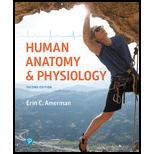
Which of the following are considered parts of the axial skeleton? (Circle all that apply.)
a. Pectoral girdle
b. Lower limb
c. Skull
d. Vertebral column
e. Pelvic girdle
f. Thoracic cage
Introduction:
The skeletal system provides the framework for the body. The human skeletonconsists of 270 bones at the time of birth, but the number decreases to 206 inadulthood because of the fusion of some bones. The human skeletal system is dividedinto two parts: axial skeleton, whichmaintainsan upright posture of the human body, and appendicular skeleton, whichconsists of limbs and girdles. Appendicular skeleton helps in the movement of the body.
Answer to Problem 1CYR
Correct answer:
The parts of the axial skeleton are skull, vertebral column, andthoracic cage.
Explanation of Solution
Justification/explanationfor the correct answer:
Options (c), (d), and (f) areskull, vertebral column, as well as thoracic cage, respectively. The axialskeleton consists of 80 bones. The skull is composed of 22 bones, out of which eightare cranial bones and 14 are facial bones, whichmake the framework for the face. The vertebral column is composed of 33 bones, out of which 24 bonessurround the spinal cord, and two inferior bones, namely, the sacrum (5 fused vertebrae) and coccyx (4 fused vertebrae), are fused with each other. The thoracic cage has 12 pairs of ribs, whichprotect the lungs and heart. Hence, options (c), (d), and (f) are correct.
Explanation for the incorrect answers:
Option (a) is pectoral girdle. Pectoral girdle surrounds and supports the upper limbs. Itcontains two bones: clavicle and scapula, and is not a part of the axial skeleton. So, it is an incorrect option.
Option (b) is lower limb. The lower limb consists of three parts, which are femur(thigh), tibia, and fibula (leg), and foot bone comprising tarsals, metatarsals, and phalanges. Theselimbs hold the upper part of the body. Theyhelp in locomotion and are not a part of the axial skeleton. So, it is an incorrect option.
Option (e) is pelvic girdle. Pelvic girdle consists of two pelvic bones and the sacrum. It supports the pectoral girdle. The pelvic bone consists of three fused bones, namely, ilium, ischium, and pubis. It is also not apart of the axial skeleton. So, it is an incorrect option.
Hence, options (a), (b), and (e) are incorrect.
Thus, it can be concluded that the skeletal system of a humancomprisestwo parts. The parts of the axial skeletonare skull, vertebral column, and thoracic cage. So, options (c), (d), and (f) are correct.
Want to see more full solutions like this?
Chapter 7 Solutions
Human Anatomy & Physiology Plus Mastering A&P with Pearson eText -- Access Card Package (2nd Edition) (What's New in Anatomy & Physiology)
- State the five functions of Globular Proteins, and give an example of a protein for each function.arrow_forwardDiagram of check cell under low power and high powerarrow_forwarda couple in which the father has the a blood type and the mother has the o blood type produce an offspring with the o blood type, how does this happen? how could two functionally O parents produce an offspring that has the a blood type?arrow_forward
- What is the opening indicated by the pointer? (leaf x.s.) stomate guard cell lenticel intercellular space none of thesearrow_forwardIdentify the indicated tissue? (stem x.s.) parenchyma collenchyma sclerenchyma ○ xylem ○ phloem none of thesearrow_forwardWhere did this structure originate from? (Salix branch root) epidermis cortex endodermis pericycle vascular cylinderarrow_forward
- Identify the indicated tissue. (Tilia stem x.s.) parenchyma collenchyma sclerenchyma xylem phloem none of thesearrow_forwardIdentify the indicated structure. (Cucurbita stem l.s.) pit lenticel stomate tendril none of thesearrow_forwardIdentify the specific cell? (Zebrina leaf peel) vessel element sieve element companion cell tracheid guard cell subsidiary cell none of thesearrow_forward
- What type of cells flank the opening on either side? (leaf x.s.) vessel elements sieve elements companion cells tracheids guard cells none of thesearrow_forwardWhat specific cell is indicated. (Cucurbita stem I.s.) vessel element sieve element O companion cell tracheid guard cell none of thesearrow_forwardWhat specific cell is indicated? (Aristolochia stem x.s.) vessel element sieve element ○ companion cell O O O O O tracheid O guard cell none of thesearrow_forward
 Concepts of BiologyBiologyISBN:9781938168116Author:Samantha Fowler, Rebecca Roush, James WisePublisher:OpenStax College
Concepts of BiologyBiologyISBN:9781938168116Author:Samantha Fowler, Rebecca Roush, James WisePublisher:OpenStax College- Basic Clinical Lab Competencies for Respiratory C...NursingISBN:9781285244662Author:WhitePublisher:Cengage
 Medical Terminology for Health Professions, Spira...Health & NutritionISBN:9781305634350Author:Ann Ehrlich, Carol L. Schroeder, Laura Ehrlich, Katrina A. SchroederPublisher:Cengage Learning
Medical Terminology for Health Professions, Spira...Health & NutritionISBN:9781305634350Author:Ann Ehrlich, Carol L. Schroeder, Laura Ehrlich, Katrina A. SchroederPublisher:Cengage Learning Human Biology (MindTap Course List)BiologyISBN:9781305112100Author:Cecie Starr, Beverly McMillanPublisher:Cengage Learning
Human Biology (MindTap Course List)BiologyISBN:9781305112100Author:Cecie Starr, Beverly McMillanPublisher:Cengage Learning





